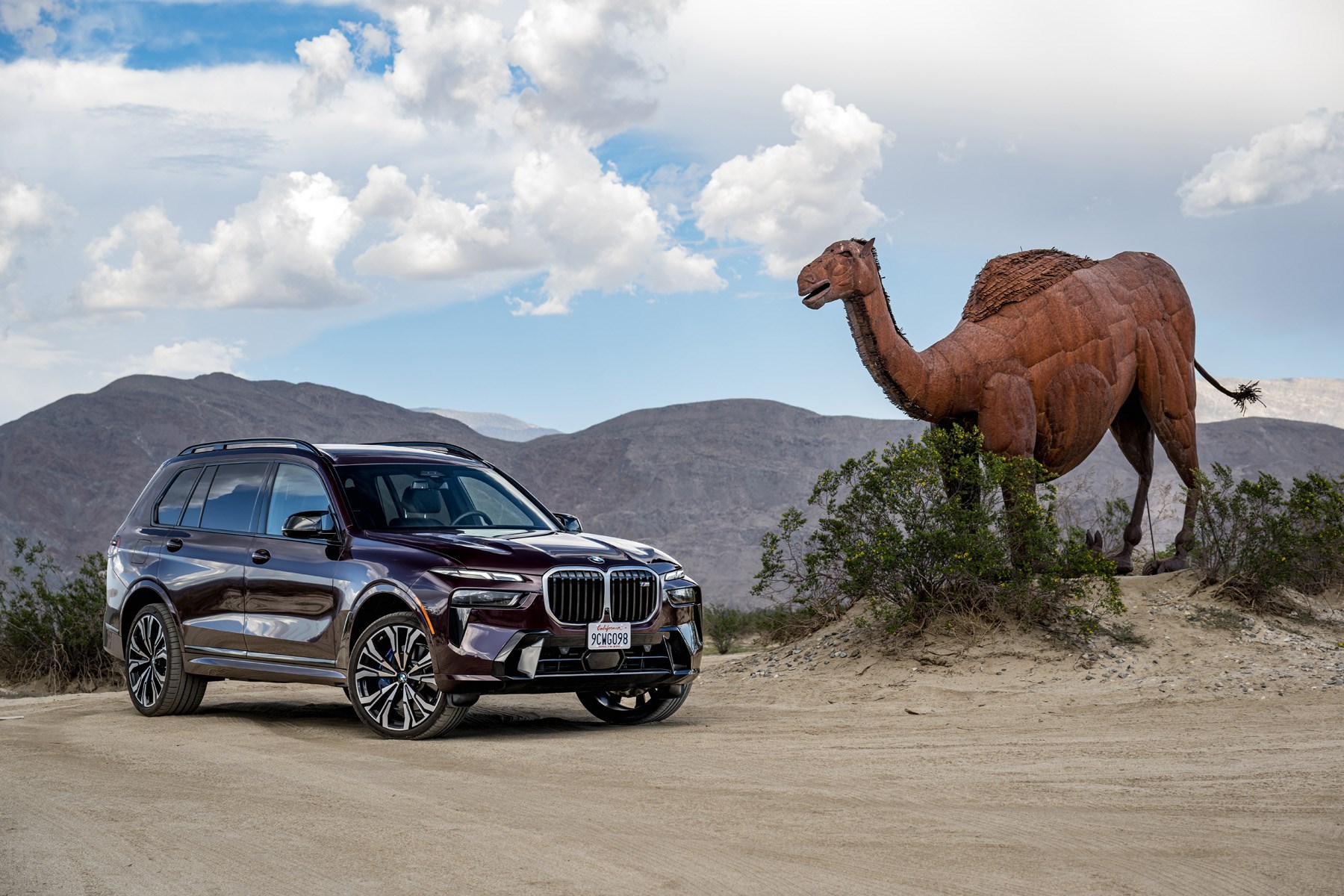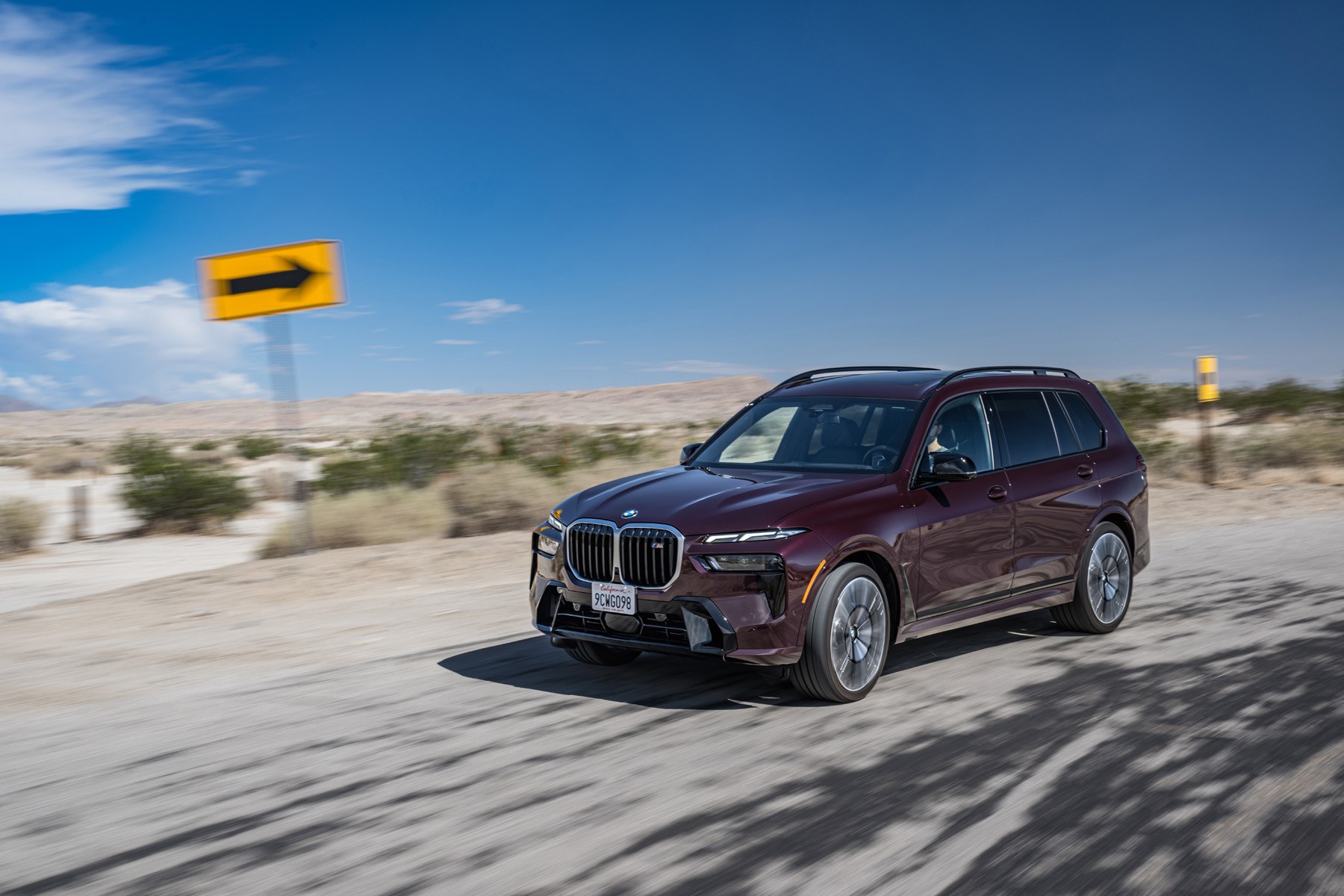► Controversial looks
► Yet practical and enjoyable to drive
► Seven seats executed well
The BMW X7 is what you can get when you take a BMW 7 Series, swap out the saloon body for an SUV shell, add in a couple of seats and give it the kind of off-road ability that looks great in the brochure but will almost certainly never be tested in the real world. In other words, it’s the biggest, baddest SUV that BMW makes – and for 2023 it’s had a facelift.
It doesn’t feel it, but the X7 is now mid-way through its life cycle having launched in 2019 and needs this refresh in order to keep it on-par with the new seventh-gen 7 Series. For those that didn’t like the looks of the original X7, then the bad news is you’re probably not going to like this one, either. BMW’s doubled-down on the controversy of its latest designs by complementing the ginormous grille with the headlight design and front apron from the 7 Series. Bold.
Love or hate the looks, there’s no denying that the initial X7 was a very, very competent car, so what has this update done for its standing among rivals such as the Mercedes-Benz GLS and Range Rover. Read on to find out…
Not just about new headlights
Further visual tweaks include the ‘Iconic Glow’ ambient lighting around the grille and, wait for it, 23-inch alloy wheels – the largest factory spec rims that BMW has ever supplied. If that’s not your cup of tea then rest assured that the positively tiny 21-inch versions are standard. BMW’s made some tweaks at the rear end, with 3D sculpted lights and a full-width chrome bar that sits underneath a glass cover.

Inside, the X7 gets the same infotainment setup as the rest of the 7 family. That means a 12.3-inch digital instrument panel replacing traditional dials, as well as a 14.9-inch curved central screen that runs BMW’s latest iDrive operating system, 8.0. Predictably, it’s rather brilliant and while most users will take some time to get used to its myriad functions, the interface and quality of software design is superb.
A refreshed engine line-up is also on the menu (all featuring 48v mild-hybrid assistance), with the M50i xDrive being replaced by the M60i xDrive, as well as updated xDrive40i and xDrive40d versions. What’s more, while the seven-seat version of the X7 is still standard, buyers can choose to have a six-seat option with bigger, more comfortable seats in the second row.
What’s it like to drive?
It’s certainly a serene environment with two-axle air suspension and electronically controlled dampers There’s a cushioned lull to suspension movements, but while this is very much a comfort-focussed experience, it never feels like you’re sloshing about because suspension movements are so nicely regulated. Admittedly, we haven’t yet tried the car on the new 23-inch alloys, but we suspect the ride will remain surprisingly polished.

The seats are highly comfortable, it’s as if wind- and road-noise has been snuffed out by goose-down pillows, and the Bowers and Wilkins hi-fi in our car basically turned the entire cabin into a pair of expensive noise-cancelling headphones.
It goes well, too. Of the engines available post facelift, we’ve driven the top-dog M60i xDrive and it’s got all the guts you’d expect from a 4.4-litre twin-turbo V8. Brawny low down and reasonably keen to rev, its 530hp and 553lb ft torque output propel the 2.7-tonne X7 from 0-62mph in just 4.7 seconds and onto a top speed of 250km/h. Sounds the part, too, with a M-Division rumble emanating from under the humongous bonnet.
Does it go around corners?
Despite the cushy ride, BMW engineers have targeted best-in-class dynamics – indeed, one chassis expert with a background in WTCC and DTM was quick to quash any fears that this would be BMW’s least dynamic car (and mumbled something about front-wheel-drive 2-series).
Chassis tuning was even conducted at the Nürburgring. Apparently the chassis engineers reached an impasse until someone suggested they changed tack from a conservative chassis set-up to one as agile as possible, with software for the all-wheel drive, steering, differential and suspension layered on to keep owners out of trouble. ‘It took two months but immediately it went five seconds faster at the Nürburgring,’ says our man. You’d certainly move out of its way on the touristfahrten days.

We didn’t drive it on the ’Ring, but some of the windier roads on our California test route (it’s a myth that American tarmac is all set in a straight line) the X7 performed with aplomb. The steering had a familiarly pacey, weighty and precise feel, and the X7 certainly turned in well, resisted roll, gripped hard and felt suitably rear-biased when driven more aggressively. It feels both far more dynamic than expected, and like a much smaller, nimbler machine that the proportions suggest.
Does the X7 actually go off-road?
It does. Ground clearance of 221mm, all-wheel drive and air suspension that can be raised by up to 40mm should more than cope with most owners’ demands, but BMW is happy to leave the really serious terrain to Land Rover, barely mentions off-road capability in the press material and didn’t include any off-roading on the press launch.
It’s also telling that the xOffroad package is optional, with four off-road modes (the unnecessarily pre-fixed xSand, xRocks, xGravel and xSnow), mechanical diff lock and sump guard.
Can it do tip runs? Carry three generations at once?
It can. The X7 comes as standard with seven seats. Row two can be moved forwards and back by up to 14.5cm so you can flex the ratio between space for those occupants, or for people or luggage behind. The seat backs also split 60/40 as standard.
Row two tilts forward to provide access to row three. It’s a bit of a squeeze getting back there and out again, but there’s decent space for two full-size adults once seated, and even armrests, cupholders, heated seats and the option of air vents and a climate-control panel.
Row three also includes Isofix child-seat mounting points – not all seven seaters do, which means child seats have to be locked into row two, with the knock-on that accessing row three is harder for other passengers. Not in the X7. So if you’ve got a young family and regularly carry more than five, the X7’s rear Isofix is a real bonus.
With all three rows raised, the boot is smaller than a Golf’s at 326 litres (the electric split tailgate actually helps to stop the stuff you’ve crammed in falling out) but row two and three can electrically lowered at the press of a button, providing 750 litres and 2120 litres of space respectively.

A more opulent six-seat layout is available, which switches the middle-row bench for a pair of captain’s chairs. Clearly, you’ll need to leave one passenger at the kerb and you lose the ability to fold row two completely flat and carry really big loads, but there’s more space and comfort for the two remaining, and the gap between the seats makes getting back to row three easier.
Anything else?
The increased array of driver assistance systems is certainly worth a mention and includes a broader range of functions from the front-collision warning system, a new exit warning function (alerts occupants to a risk of collision when opening the door) and something called Manoeuvre Assistant.

Doing pretty much what it says on the tin, it’s especially useful if your parking space is in a tight parking garage. The function will memorise how to get into the spot and then, when the starting point is reached again, will repeat the manoeuvre by taking control of the steering, brakes, accelerator and forward and reverse gearshifts. Overkill? Maybe. But there’s no denying how effectiveness it is.
BMW X7: verdict
For a car that’s easy to dislike on account of its sheer bulk and those frankly monstrous kidney grilles, there’s actually a lot to enjoy once you’re aboard the BMW X7, and there’s no doubt its mix of luxurious refinement, seven-seat versatility and dynamic ability is unmatched by any rivals for comparable money.